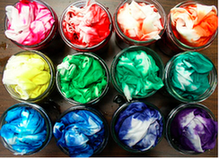
Fabric dye and its dyeing technology have a high impact on the environment. The high use of harmful chemicals, amount of high energy wasted and high water wastage is leaving their footprints. Due to the visible impact of these footprints, consumers have started demanding eco-friendly fabrics, and manufacturers and marketers are also finding alternatives to harmful dyeing technology.
Can Fiber Dye be Eco-Friendly?
Yes, eco-friendly dye is possible with different techniques. Natural dyeing derived from fungi, plants, fruit, algae, and marine invertebrates is some technique to get eco-friendly dyeing.
Fiber Reactive Dye
It’s a dye that can have an immediate impact on the fabric. A chemical reaction between the molecules of the fabric and the dye causes the dye to attach to the fibres. The procedure used to create the fabric’s component elements is permanent. Silk, viscose, hemp, and bamboo materials all respond well to fibre active dyes. Using fiber-reactive dyes does not necessitate the use of mordants. Compared to regular fabrics, fiber-reactive dyes also utilise less salt, water, and heavy metals. because this dye can be used to maintain the colour, which is permanent.
Biodegradable Dyes
This dye does not require amines, heavy metals, and inorganic salts and easily decomposes without leaving any kind of landfill in the environment. Pigments, reactive fibres, and biodegradable materials can all be used to save water and lessen environmental damage.
Plant-based Dyes
Leaves, fruits, roots, flowers, and barks can be used for the natural fabric dye process. Different colors can be obtained from different parts of the tree such as bark giving brown color, roots giving yellow colors, and sappan wood tree pods giving us red color.
Animal-based Dyes
Dyes can be obtained from dried bodies of animals and insects such as kermes, cochineal, and lac. Cochineal is a brilliant dye obtained from insects living on cactus plants and gives red color. Tyrian and Carmine purple dye is derived from shellfish and cochineal respectively.
Minerals
Minerals dye includes iron black, iron buff, chrome yellow, manganese bistre, and Prussian blue.
Microorganisms
Natural colors can be obtained from bacteria, fungi, and algae which are fast-growing and have the potential of being standardized commercially. Serratia spp, chitosan, and Alternaria alternate were used to obtain dyes. The natural red color is obtained from Monascus Anka and the fungus Echinodontium tinctorium.
Fabric Dyeing Techniques that are Eco Friendly
Eco Bleaching
This technique is used to remove any natural color and impurities from the fiber and to increase its whiteness. It is a process where non-chloric substances like hydrogen peroxide are used to whiten the fabric without releasing any kind of harmful chemical during the process.
Green Bleaching
Silicon and natural phosphate are used in this technique when both elements are used with cow dung and exposed to the sun, it bleaches natural fabrics.
Low-temperature bleaching
Peroxide activators are used during the low-temperature bleaching process to both slow down degradation and achieve the desired whiteness. Up to 50% less carbon dioxide is emitted, and no methane gas is used in the process.
Enzyme solution
A specific enzyme solution can be used to dye fabric, eliminating the requirement for singeing. We can get rid of any extra colour by enzyme-washing, particularly knitted garments. For every tonne of knitted fabric produced, this procedure can prevent the emission of thousands of kilogrammes of carbon dioxide and thousands of litres of water. Energy usage and carbon dioxide emissions are reduced when enzymes are used in place of chemicals.
The Bottom Line
There are various natural dyeing techniques as discussed above that can be used for fabric making process easy, cost-effective, and environment friendly. You can use natural dyeing techniques such as plants, roots, fruits, flowers, and microorganisms to make the process eco-friendly. But due to the heavy demands, lots of people are using chemical-based processes for faster production which is harmful to the environment and users’ skin. So, choose and use the dyeing technique wisely.